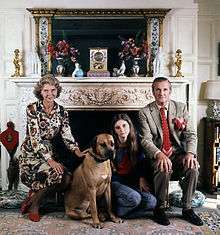Henry Thynne, 6th Marquess of Bath

Henry Frederick Thynne, 6th Marquess of Bath JP (26 January 1905 – 30 June 1992), styled Lord Henry Thynne until 1916 and Viscount Weymouth between 1916 and 1946, was a British aristocrat, landowner and Conservative Party politician.
Background and education
Lord Bath was the second but eldest surviving the son of Thomas Thynne, 5th Marquess of Bath and Violet Mordaunt, the illegitimate daughter of Harriet Mordaunt and Lowry Cole, 4th Earl of Enniskillen. He was educated at The New Beacon Preparatory School, Harrow and Christ Church, Oxford. In 1916 he became the heir to the family titles and estates after his elder brother John was killed in action in the First World War.
In the 1920s the tabloid press considered him one of the bright young things.
Political and military careers
As Viscount Weymouth, he was elected as the Member of Parliament (MP) for Frome between 1931 and 1935, and served as a member of the Council of the Duchy of Cornwall from 1933 to 1936 and Justice of the Peace for Wiltshire in 1938.
He gained the rank of Major in the service of the Royal Wiltshire Yeomanry, fought in the Second World War, and was awarded the Bronze Star[1] and the Silver Star for actions during that period.
Thynne succeeded his father as Marquess of Bath in 1946. He was noted for his forestry work on the ancestral estate of Longleat. It was he who developed the safari park and opened the house to the public in 1949.[2]
Family
On 27 October 1927 Lord Weymouth married, firstly, Daphne Vivian, daughter of George Vivian, 4th Baron Vivian, and they were divorced in 1953. They had five children:
- Lady Caroline Jane Thynne (1928–1995), married David Somerset, 11th Duke of Beaufort and had issue
- Thomas Timothy Thynne (1929–1930), died in infancy
- Alexander George Thynn, 7th Marquess of Bath (b. 6 May 1932)
- Lord Christopher John Thynne (b. 9 April 1934), married Antonia Palmer, daughter of Sir Anthony Palmer, 4th Baronet and had issue
- Lord Valentine Charles Thynne (1937–1979), married firstly, Veronica Jacks and had issue. He married secondly, Susanne Alder and married thirdly, Liese Dennis.
After becoming Lord Bath he married, secondly, Virginia Penelope Parsons (1917-2003), on 15 July 1953, following her divorce earlier that year from David Tennant.[3] They had one daughter:
- Lady Silvy Cerne Thynne (b. 22 December 1958), married Iain McQuiston and has issue
Titles
- Lord Henry Thynne, 1905–1916
- Viscount Weymouth, 1916–1931
- Viscount Weymouth, MP, 1931–1935
- Viscount Weymouth, 1935–1946
- The Most Honourable The Marquess of Bath, 1946–1992
References
- ↑ The London Gazette: (Supplement) no. 36791. p. 5189. 10 November 1944. Retrieved 2012-06-25.
- ↑ Hugo Vickers Obituary: Henry Thynne, 6th Marquess of Bath, The Independent, 1 July 1992
- ↑ "From bohemia to a life of nobility". Sydney Morning Herald. 31 October 2003. Retrieved 3 June 2014.
- ↑ Burke, Sir Bernard, (1938 ed) Burke's Peerage, Baronetage and Knightage. Shaw, London. p.243
- 1 2 3 Woodfall, H. (1768). The Peerage of England; Containing a Genealogical and Historical Account of All the Peers of that Kingdom Etc. Fourth Edition, Carefully Corrected, and Continued to the Present Time, Volume 6. p. 258.
- 1 2
 Lee, Sidney, ed. (1898). "Thynne, William". Dictionary of National Biography. 56. London: Smith, Elder & Co.
Lee, Sidney, ed. (1898). "Thynne, William". Dictionary of National Biography. 56. London: Smith, Elder & Co. - ↑ Girouard, Mark, Thynne, Sir John (1515–1580), estate manager and builder of Longleat in Oxford Dictionary of Biography (Oxford University Press, 2004)
- ↑ Booth, Muriel. "THYNNE, John (?1550-1604), of Longleat, Wilts.". History of Parliament. The History of Parliament Trust. Retrieved 2 January 2016.
- ↑ Lancaster, Henry; Thrush, Andrew. "THYNNE, Charles (c.1568-1652), of Cheddar, Som.". History of Parliament. The History of Parliament Trust. Retrieved 2 January 2016.
- ↑ Rugh, R. B.; Critall, Elizabeth. "'Parliamentary history : 1529-1629', in A History of the County of Wiltshire: Volume 5". British History Online. Victoria County History. Retrieved 2 January 2016.
- ↑ Ferris, John P. "THYNNE, Sir James (c.1605-70), of Longbridge Deverill, Wilts.". History of Parliament. The History of Parliament Trust. Retrieved 2 January 2016.
- ↑ Helms, M. W.; Ferris, John P. "THYNNE, Sir Thomas (c.1610-c.69), of Richmond, Surr.". History of Parliament. The History of Parliament Trust. Retrieved 2 January 2016.
- ↑ Marshall, Alan. "Thynne, Thomas". Oxford Dictionary of National Biography. Retrieved 2 January 2016. (subscription required (help)).
- ↑ Heath-Caldwell, J. J. "Thomas Thynne, 1st Marquess of Bath, 3rd Viscount Weymouth". JJ Heath-Caldwell. Retrieved 2 January 2016.
- ↑ Hayton, D. W. "THYNNE, Hon. Henry (1675-1708).". The History of Parliament. The History of Parliament Trust. Retrieved 2 January 2016.
- ↑ Dunaway, Stewart (2013). Lord John Carteret, Earl Granville - His Life History and the Granville Grants. Lulu. p. 33. ISBN 9781300878070.
- ↑ "Bath, Thomas Thynne". Encyclopedia Britannica 1911. Retrieved 2 January 2016.
- ↑ Thorne, Roland. "Carteret [formerly Thynne], Henry Frederick". Oxford Dictionary of National Biography. Retrieved 2 January 2016.
- ↑ "Thomas Thynne, 2nd Marquess of Bath (1765-1837)". National Portrait Gallery. Retrieved 2 January 2016.
- ↑ Escott, Margaret. "THYNNE, Lord Henry Frederick (1797-1837), of 6 Grovesnor Square, Mdx.". History of Parliament. The History of Parliament Trust. Retrieved 2 January 2016.
- ↑ "John Thynne, 4th Marquess of Bath (1831-1896), Diplomat and landowner". National Portrait Gallery. Retrieved 2 January 2016.
External links
- Hansard 1803–2005: contributions in Parliament by Henry Thynne, 6th Marquess of Bath
| Parliament of the United Kingdom | ||
|---|---|---|
| Preceded by Frederick Gould |
Member of Parliament for Frome 1931–1935 |
Succeeded by Mavis Tate |
| Peerage of Great Britain | ||
| Preceded by Thomas Thynne |
Marquess of Bath 1946–1992 |
Succeeded by Alexander Thynn |